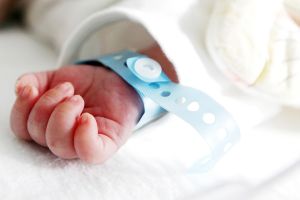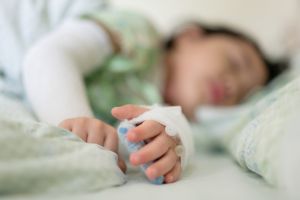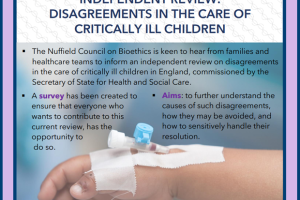18 Sep 2023
Blog post
Making unbearable decisions about the care and treatment of a seriously ill child – ethical reflections
In light of the recent judicial scrutiny of the case of Charlie Gard, Katharine Wright, Assistant Director of the Nuffield Council on Bioethics, considers the ethical issues at stake in such cases, and what scope there is for change in the future to make such situations less unbearable for families and professionals alike. This blog draws on the conclusions of three past inquiries conducted by the Council, concerned with: critical care decisions for babies; the involvement of children in clinical research; and the regulation of novel neurotechnologies.
It is hard to imagine decisions more harrowing than those that have to be made in connection with the care and treatment of a very seriously ill child. There is widespread agreement that a child’s ‘best interests’ are the touchstone in such cases, and that there should be a presumption in favour of seeking to prolong life, unless there are clear indications that the life to be experienced would be an intolerable burden on the child. However, how those interests are to be judged, and by whom, is a much more difficult question – especially given the difficulties in quantifying pain and suffering experienced by a child who cannot communicate; uncertainties about how the child’s condition might develop; and the scope for profound and irreconcilable disagreement regarding judgments about the quality or tolerability of the life the child might have in the future, if treatment were to be initiated or continued.
The starting point in such decisions has to be the parents. Children do not exist within a vacuum, but are situated within their families. Parents have both the legal and moral responsibility to make healthcare decisions on their young children’s behalf and, other than in an emergency, this responsibility can only be superseded in the UK through the decisions of a court. The state, in the form of the courts, does not normally seek to intervene with parental decision-making unless either genuine concerns are raised with respect to harm, or there are irreconcilable differences with respect to decisions about a child’s welfare. Such differences may arise between parents. They may also arise between parents and others such as healthcare professionals who have a responsibility towards the child. In such cases, one of the parties, or exceptionally a third party with a legitimate interest in the child’s welfare, may seek a ruling from the courts, and over the years, judges have developed expertise in addressing such cases.
But what are these responsibilities borne by those who are not parents? Health professionals do not have parental responsibilities towards the children for whom they are providing care. But they do have professional responsibilities to all their patients – in the words of the General Medical Council: “to make the care of your patient your first concern”. When the patient is a child, professionals also have responsibilities towards the child’s parents: to support them both in their decision-making, and in coping with their own distress and anxiety about their child. However, critically, professionals have primary clinical and legal responsibilities directly to the child, as their patient. Consent to a particular treatment on the part of a parent authorises that treatment, but cannot mandate it if, in the professional judgment of the health professional, that treatment is not in the child’s best interests.
So this brings us back to the challenging question of how those interests are to be determined, and by whom. Ideally, decisions should be made, and parents supported, through a ‘partnership of care’ between parents and the healthcare team. The healthcare team should participate actively in critical care decisions, and indicate what, in their professional opinion, is best for the child. However, they also need to be mindful that their professional knowledge does not enable them to predict the future health of a baby with complete accuracy, or give them any special moral authority with regard to factors such as judgments about quality of life. In our 2006 report on critical care decisions for very young babies, we put forward proposals for a more transparent and structured set of criteria for judging best interests when deciding whether to institute or withhold further treatment. These included consideration of the degree of pain, suffering and mental distress associated with the proposed treatment; the extent to which the treatment is likely to extend the child’s life for a significant time (noting that it will not generally be in a child’s interests to prolong the process of dying); what benefits the treatment may bring, and whether these outweigh the burdens; and the views and feelings of the parents, especially with respect to the question of whether likely benefits outweigh likely burdens. ‘Best interests’ are not only a matter for clinical judgment, but concern the question of what kind of life the child may live, and it is essential that the voices of parents, who will be sharing that life with their child, are heard.
Unfortunately, such a partnership of care cannot always be achieved, and recourse to the courts may become the only option. In some cases, the opportunity for a court to consider, independently, what course of action would be ‘best’ for a child has been highly valuable in finding a way forward where there are genuine and sincerely held differences of opinion, and where parents, professionals and others are drawing on different facts and emotions in making their decisions. Court proceedings also ensure that the baby has an independent voice, through the role of the guardian appointed to investigate and represent the baby’s interests. But court involvement sadly also often leads to the souring of an already very difficult relationship, and to the polarisation of views. Lack of legal aid may make it very difficult for parents to be properly represented. And healthcare professionals may be put in the position of having to continue providing treatment that they believe to be contrary to a child’s interests, even actively harmful, pending the final outcome of the court process.
These negative factors associated with the involvement of the courts highlight the importance of mechanisms designed to support more active resolution of differences before they become entrenched. These include the opportunity of obtaining second opinions; advice and support from clinical ethics committees, including access to on-call facilitators; and access to mediation: a recommendation in our 2006 report which was strongly reiterated in Mr Justice Francis’ final judgment on 24 July 2017.
But, however many of these systems are in place, there will still be cases where relationships break down and where court hearings will be the only way forward. Such relationship breakdown seems particularly likely to arise where the interventions being sought are experimental – neither part of mainstream medicine, nor offered as part of a clinical research study (with all the associated scrutiny and safeguards). We know from the consultation responses we received to our 2015 inquiry into the involvement of children in clinical research, that parents may be willing to do anything to get a particular new intervention for their child in cases where serious illness has been diagnosed and where conventional therapies are ineffective or non-existent. Moreover, this is not an issue confined to very ill babies and children. Adult patients and their families may be similarly willing to ‘try anything’ if they have come to the end of the road with approved medical treatments.
Such new interventions may at times, and with the benefit of hindsight, turn out to the turning point in the treatment of a particular condition. However, they may offer false hope, or may even exacerbate the physical or emotional distress of both patient and family at the end of the patient’s life. No one can criticise patients or families for searching by any means possible to find a treatment that appears to offer a chance of hope. However, that depth of need and desperation makes it essential that those promoting a novel intervention (whether commercial enterprises or individual researchers or health professionals) recognise their own responsibilities: particularly with respect to the way in which they present the evidence as to the likelihood of that intervention genuinely offering prospect of benefit for the patient.
The Declaration of Helsinki permits the provision of innovative or experimental treatments outside the context of research within the discretion of health professionals. Such use, however, is controversial because of the potential lack of scrutiny and associated safeguards that are required for research. We have argued in past inquiries that a necessary corollary of the licence to exercise such discretion is found in the expected virtues or characteristics of professional practice: in particular in responsibility in avoiding hype and false promise; humility in acknowledging the limits of current knowledge; and trustworthiness – an essential pre-requisite in the creation of trust and trusting relationships.Alongside an emphasis on such virtues as an important factor in ethical professional practice, there is also a need for clear and specific ethical guidance for health professionals pursuing experimental therapies – guidance which is currently lacking. We suggested in our 2013 report on novel neurotechnologies, that such guidance should aim to adopt the best features of the regulatory approaches to treatment and research, including:
- an emphasis on the primacy of patient interests, entailing a duty of care that persists beyond the period of experimentation;
- the need for the intervention to be grounded in an evidence base that is appropriate to the (necessarily) exploratory context; and
- the awareness that the pursuit of an intervention solely because it putatively represents a patient’s ‘last best hope’ is likely to be too cavalier to justify an experimental intervention.
The recent difficult and distressing court proceedings have only served to reiterate the need for such guidance, for the better support of patients, families, professionals, and researchers alike.
Written in consultation with Margot Brazier (Chair of the Critical care decisions working party); Bobbie Farsides (Chair of the Children and research working party); and Dave Archard (Chair of the Nuffield Council on Bioethics and member of the Critical care decisions working party. Dave is also a member of the Great Ormond Street Hospital Clinical Ethics Committee (CEC). The CEC has not been involved in writing this blog post.)






Comments (0)
Join the conversation